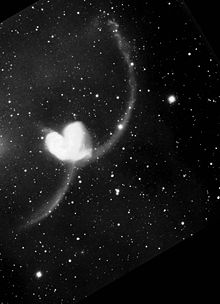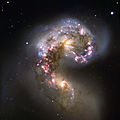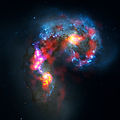- Antennae Galaxies
-
Antennae Galaxies 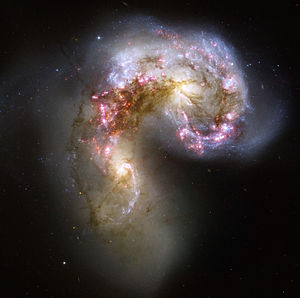
NGC 4038 (left) & NGC 4039 (right)Observation data (J2000 epoch) Constellation Corvus[1] Right ascension 12h 01m 53.0s / 12h 01m 53.6s[2] Declination -18° 52′ 10″ / -18° 53′ 11″[2] Redshift 1642 ± 12 / 1641 ± 9 km/s[2] Distance 45 Mly / 65 Mly Type SB(s)m pec / SA(s)m pec[2] Apparent dimensions (V) 5′.2 × 3′.1 / 3′.1 × 1′.6[2] Apparent magnitude (V) 11.2 / 11.1[2] Notable features Interacting galaxies Other designations Ringtail Galaxy,[2] NGC 4038 / 4039,[2]
PGC 37967 / 37969, Arp 244,[2] Caldwell 60/61See also: Galaxy, List of galaxies The Antennae Galaxies (also known as NGC 4038/NGC 4039 or Caldwell 60/61) are a pair of interacting galaxies in the constellation Corvus. They are currently going through a phase of starburst. They were discovered by William Herschel in 1785.[3] NGC 4038 is located at RA 12h 01m 53.0s, Dec −18° 52′ 10″; and NGC 4039 at RA 12h 01m 53.6s, Dec −18° 53′ 11″.
Contents
General information
The Antennae are undergoing a galactic collision. Located in the NGC 4038 group with five other galaxies, these two galaxies are known as the 'Antennae' because the two long tails of stars, gas and dust thrown out of the galaxies as a result of the collision resemble the antennae of an insect. The nuclei of the two galaxies are joining to become one giant galaxy. Most galaxies probably undergo at least one significant collision in their lifetimes. This is likely the future of our Milky Way when it collides with the Andromeda Galaxy. Two supernovae have been discovered in the galaxies: SN 2004GT and SN 2007sr.
A recent study finds that these interacting galaxies are closer to the Milky Way than previously thought—at 45 million light-years instead of 65 million light-years.[4]
Timeline
About 1.2 billion years ago, the Antennae were two separate galaxies. NGC 4038 was a barred spiral galaxy and NGC 4039 was a spiral galaxy. Before the galaxies collided, NGC 4039 was larger than NGC 4038.[citation needed] 900 million years ago, the Antennae began to approach one another, looking similar to NGC 2207 and IC 2163. 600 million years ago, the Antennae passed through each other, looking like the Mice Galaxies. 300 million years ago, the Antennae's stars began to be released from both galaxies. Today the two streamers of ejected stars extend far beyond the original galaxies, making the antennae shape.
Within 400 million years, the Antennae's nuclei will collide and become a single core with stars, gas, and dust around it.[citation needed] Observations and simulations of colliding galaxies suggest that the Antennae Galaxies will eventually form an elliptical galaxy.[5]
X-ray source
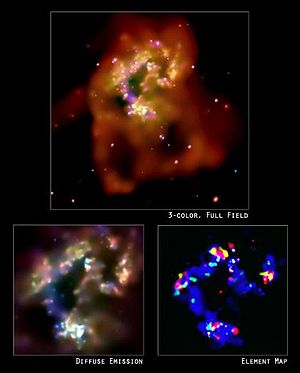 This montage of Chandra images shows a pair of interacting galaxies known as The Antennae. The top image, a wide field X-ray view, reveals spectacular loops of hot gas spreading out from the southern part of The Antenna into intergalactic space. In the closeup view on the lower left, the point sources have been taken out to emphasize the hot gas clouds in the central regions of The Antennae. The image at the lower right is processed and color-coded to show regions rich in iron (red), magnesium (green) and silicon (blue). Image is 4.8 arcmin across. Instrument: ACIS. Color code: Energy (Red: 0.3–0.65 keV, Green: 0.65–1.5 keV, Blue: 1.5–6.0 keV). Credit: NASA/CXC/SAO/G.Fabbiano et al.
This montage of Chandra images shows a pair of interacting galaxies known as The Antennae. The top image, a wide field X-ray view, reveals spectacular loops of hot gas spreading out from the southern part of The Antenna into intergalactic space. In the closeup view on the lower left, the point sources have been taken out to emphasize the hot gas clouds in the central regions of The Antennae. The image at the lower right is processed and color-coded to show regions rich in iron (red), magnesium (green) and silicon (blue). Image is 4.8 arcmin across. Instrument: ACIS. Color code: Energy (Red: 0.3–0.65 keV, Green: 0.65–1.5 keV, Blue: 1.5–6.0 keV). Credit: NASA/CXC/SAO/G.Fabbiano et al.
Rich deposits of neon, magnesium, and silicon were discovered from the Chandra X-ray Observatory analysis of the Antennae Galaxies. These elements are among those that form the building blocks for habitable planets. The clouds imaged contain magnesium and silicon at 16 and 24 times, respectively, the abundance in the Sun.
Gallery
-
Antennae Galaxies composite of ALMA and Hubble observations
See also
References
- ^ R. W. Sinnott, editor (1988). The Complete New General Catalogue and Index Catalogue of Nebulae and Star Clusters by J. L. E. Dreyer. Sky Publishing Corporation and Cambridge University Press. ISBN 0933346514.
- ^ a b c d e f g h i "NASA/IPAC Extragalactic Database". Results for NGC 4038 / 4039. http://nedwww.ipac.caltech.edu/. Retrieved 2006-12-07.
- ^ "Corvus". Universe Today. http://www.universetoday.com/guide-to-space/constellations/corvus/. Retrieved 2006-12-07.
- ^ "The Antennae Galaxies Found To Be Closer To Us". Space Daily. 2008-05-12. http://www.spacedaily.com/reports/The_Antennae_Galaxies_Found_To_Be_Closer_To_Us_999.html. Retrieved 2008-06-30.
- ^ J. E. Barnes, L. Hernquist (1992). "Dynamics of interacting galaxies". Annual Review of Astronomy and Astrophysics 30 (1): 705–742. Bibcode 1992ARA&A..30..705B. doi:10.1146/annurev.aa.30.090192.003421.
External links
- Astronomy Picture of the Day: The Antennae Galaxies (10/22/1997)
- Astronomy Picture of the Day: The Antennae (04/29/2011)
- The Register: Galactic prang fingered in star formation mystery
- ESA/Hubble News Release
- ESA/Hubble images of Antennae Galaxies
- Animations of galactic collision producing antennae structures
- Antennae Galaxies on WikiSky: DSS2, SDSS, GALEX, IRAS, Hydrogen α, X-Ray, Astrophoto, Sky Map, Articles and images
Coordinates:
 12h 01m 53s, −18° 52′ 10″
12h 01m 53s, −18° 52′ 10″The Caldwell catalogue List C1 · C2 · C3 · C4 · C5 · C6 · C7 · C8 · C9 · C10 · C11 · C12 · C13 · C14 · C15 · C16 · C17 · C18 · C19 · C20 · C21 · C22 · C23 · C24 · C25 · C26 · C27 · C28 · C29 · C30 · C31 · C32 · C33 · C34 · C35 · C36 · C37 · C38 · C39 · C40 · C41 · C42 · C43 · C44 · C45 · C46 · C47 · C48 · C49 · C50 · C51 · C52 · C53 · C54 · C55 · C56 · C57 · C58 · C59 · C60 · C61 · C62 · C63 · C64 · C65 · C66 · C67 · C68 · C69 · C70 · C71 · C72 · C73 · C74 · C75 · C76 · C77 · C78 · C79 · C80 · C81 · C82 · C83 · C84 · C85 · C86 · C87 · C88 · C89 · C90 · C91 · C92 · C93 · C94 · C95 · C96 · C97 · C98 · C99 · C100 · C101 · C102 · C103 · C104 · C105 · C106 · C107 · C108 · C109See also Categories:- Spiral galaxies
- Barred spiral galaxies
- Unbarred spiral galaxies
- Peculiar galaxies
- Interacting galaxies
- NGC 4038 Group
- Corvus constellation
- NGC objects
- PGC objects
- Arp objects
- Caldwell objects
Wikimedia Foundation. 2010.

